Tax rates, classes, & rules
Set up and manage tax rules for your Shopgate mobile shop.
For specific rules for Germany, please read Steuern einrichten.
Get started
Understanding tax rules
Taxes in your Shopgate mobile shop are controlled by tax rules. There are three important variables that define a tax rule:
| Description | Example | |
| Tax Rate | A number displayed as a percentage, with which taxes are calculated. | 8.25% for the sales tax in California |
| Product Tax Class | An identifier that is assigned to a product. This defines the tax class for a product. |
"Taxable" "Tax-free" |
| Customer Tax Class | An identifier that is assigned to a customer. This defines the tax class for a customer. |
"Retail" "Wholesale" |
When you have all of the three variables above, you can define a tax rule which makes actions happen. Think of it like this: a tax rule is a logical combination of the tax rate, product tax class, and customer tax class you are working with.
Check your shop system
If you use one of the following shopping cart systems, your tax rates, tax classes, and tax rules can be imported from your desktop shop automatically.
| Magento | PrestaShop | Shopware 3.5+4 | Plentymarkets | GambioGX |
| xt:Commerce 3+4 | Shopify | Oxid | Modified eCommerce | OsCommerce |
| 3dCart | Open Cart | Zencart | WooCommerce |
After all the tax settings have been imported, please make sure to verify if all settings have been imported correctly.
If your shop system is not listed above, and your tax information is not imported after a product import, please read on to learn how to configure your taxes manually.
Configure tax rules manually
Follow the steps below to go to your tax configuration page:
- Log in to your Shopgate Admin and navigate to Settings → Taxes.
- The Taxes page will open. We will explore how to add tax rates, product tax classes, customer tax classes, and configure tax rules below.
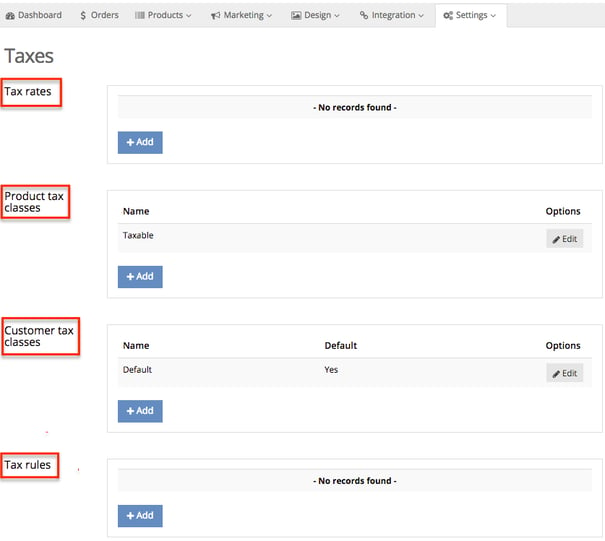
Tax rates
To create a tax rate, follow and repeat these steps until you have created all tax rates necessary:
|
 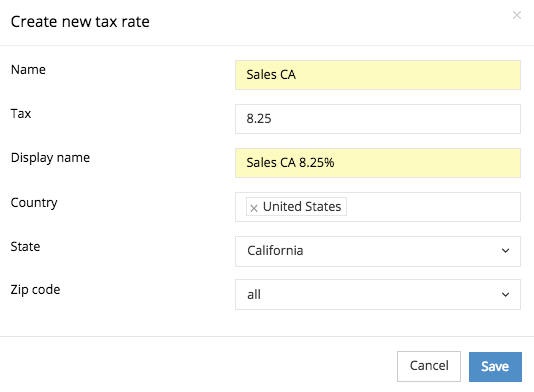 |
This table will help you understand the options shown above:
| Name | Assigned to a tax rate to configure tax rules. Make sure to use the same name as configured in your desktop shop. This is not visible to your customers. |
| Tax (%) | The actual tax rate in percentage form. For example, enter 8.25 for a rate of 8.25%. |
| Display name | The tax rate name displayed on your Shopgate Admin page. This name is not visible to your customers. |
| Country |
Select a country in which this tax rate will apply. More options may show according to the country selected. Note that you can only select countries that your shop delivers to. To add a country, please go to your Shipping page and select it from the delivery countries. |
| State | This option can be different according to the country selected. When the United States is selected, you will be asked to select a State for this tax rate. |
| Zip code | Choose all, pattern, or range from the list. How do I configure zip codes in a pattern or a range? |
Product tax classes
To create a product tax class, follow and repeat the following steps until you have created all product tax classes necessary:
|
  |
This table will help you understand the options shown above:
| Name | Please enter a product tax name to assign to a product. Make sure to use the same name as configured in your desktop shop. This name will be used to configure tax rules. Where can I see a product's tax class? |
Customer tax classes
To create a customer tax class, follow and repeat these steps until you have created all customer tax classes necessary:
|
  |
This table will help you understand the options shown above:
| Name |
Enter a customer tax name to assign to a customer. Make sure to use the same name as configured in your desktop shop. This name will be used to configure tax rules. Note that a customer tax class will only work if your shop system supports this feature. If not, you only need to define one customer tax class (e.g. Retail). |
Tax rules
After you have entered all tax rates, product tax classes, and customer tax classes for your shop, please follow the steps here to configure a tax rule. Repeat the steps until you have created all tax rules necessary.
|
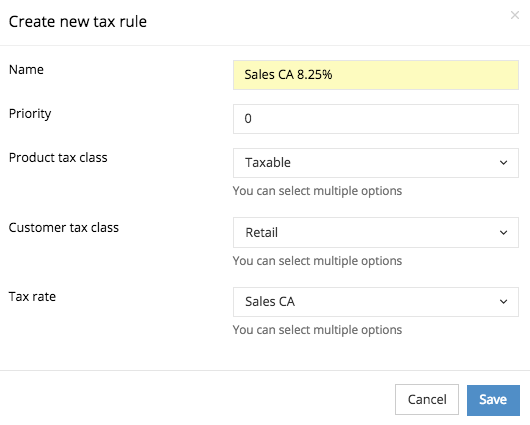  |
This table will help you understand the options shown above:
| Name | Please enter a name for the tax rule. Make sure to use the same name as configured in your desktop shop. This is not visible to your customers. |
| Priority | Enter an integer number here. For example: 0. The lowest number represents the highest priority and vice versa. How is tax calculated if multiple tax rules apply? |
| Product tax class | Select one or more product tax class(es) for this tax rule. |
| Customer tax class |
Select one or more customer tax class(es) for this tax rule, if applicable. |
| Tax rate | Select one or more tax rate(s) for this tax rule. |
Set tax rule on shipping costs
If you don't charge additional taxes on top of the shipping costs you configured in the Shopgate backend, please read this chapter to set a tax-free rule on shipping costs.
Create tax rate for shipping
|
Create a tax rate according to the steps listed above.
|
 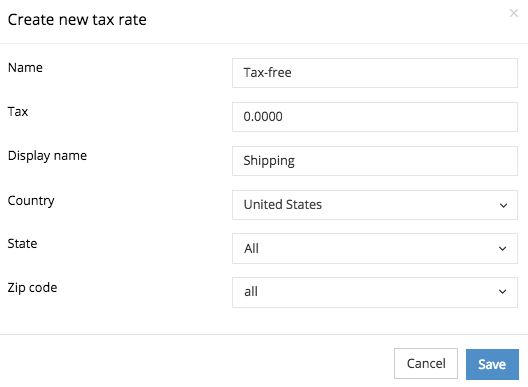 |
Create product class for shipping
|
Create a product tax class according to the steps we listed above.
|
  |
Configure tax rule for shipping
|
Create a tax rule according to the steps listed above.
|
 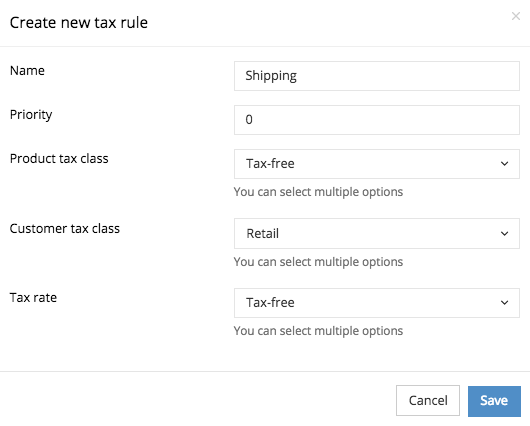 |
Verify your tax settings
After your tax settings have been imported or manually created, please make sure that the rates and rules are configured exactly the same as in your desktop shop backend.
To test your tax rules on products and shipping, go to your mobile website or apps and follow these steps:
- Test if taxes are added correctly to the products.
Put a few products in the cart, enter all necessary data, and go to the checkout page. See if taxes are calculated to the same amount as in your desktop shop. - Test if taxes of each state/country are calculated correctly.
Put a product in the cart and try to change the delivery address to a different state or country. - Test if shipping costs are taxed correctly.
Verify that the taxed amount is correct for different shipping costs.
That's it! If your tax settings are verified, you have successfully set up your tax rules for your Shopgate mobile shop.
Frequently Asked Questions
How do I configure zip codes in a pattern or a range?
To configure a series of zip codes in a pattern, use the Wild-card * to substitute single or multiple numbers, characters, spaces, etc. For example, "12*54D" stands for all zip codes that begin with "12" and end with "54D". These also include "1254D" (nothing in between) and "12 54D".
To configure a series of zip codes in a range, enter the start and end zip codes in integers. For example, enter 35810 and 35819 to include all zip codes between "35810" and "35819".
Where can I find a product's tax class?
On your Shopgate Admin page, find a product's detail page. The product's tax class will be displayed like this:


How is tax calculated if multiple tax rules apply?
If multiple tax rules apply to one product, taxes are calculated based on the priority of each rule.
This happens in two steps:
- If two or more tax rules have the same priority, the tax rate of this priority is the sum of all tax rates of the same priority.
- Rates of all priorities will be multiplied. The result will be the tax on this product.
|
For example, all following tax rules apply to one product:
Tax rates will be calculated in 2 steps:
|